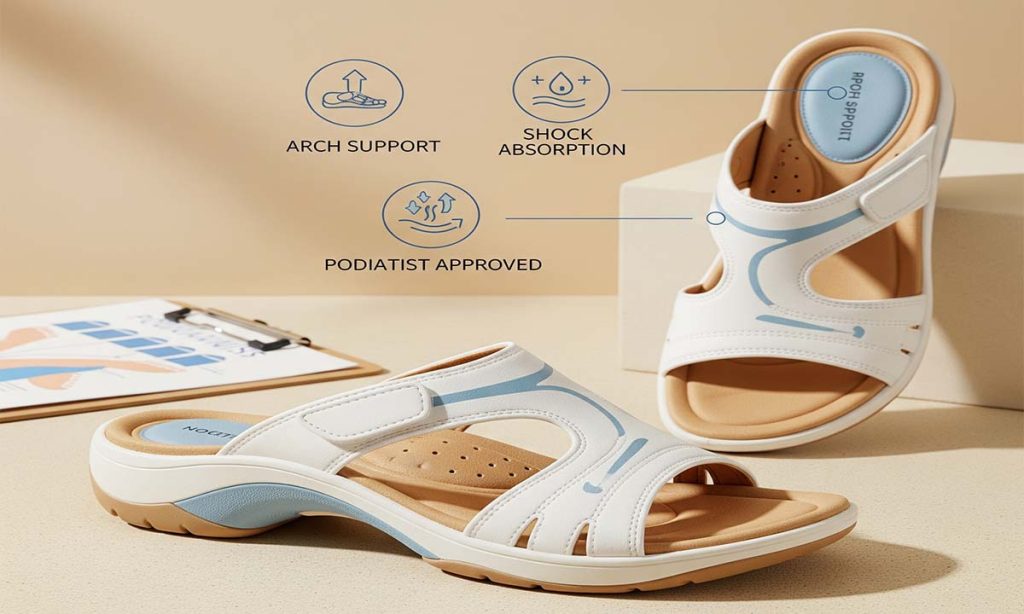Plantar fasciitis is a common foot condition causing sharp heel pain, especially in the mornings or after prolonged standing. About 10% of people will develop it at some point. Getting the right footwear is crucial: supportive sandals with good arch support and cushioning can help relieve stress on the plantar fascia and ease pain. Podiatrists agree that you don’t have to give up on sandals if you have plantar fasciitis, but you should look for the best sandals for plantar fasciitis – ones that provide stability, a deep heel cup, and shock absorption. In this guide, we’ll explain what plantar fasciitis is, which sandal features to prioritize, and review the top podiatrist-recommended sandals (including women’s styles) to help you stay comfortable and pain-free.

Table of Contents
What Is Plantar Fasciitis?
Plantar fasciitis is inflammation of the plantar fascia – a thick band of tissue running from your heel to the ball of your foot. It often results from overuse, flat feet, high arches, or sudden changes in activity. The most common symptom is sharp heel pain when taking your first steps in the morning or after sitting. Since the plantar fascia supports the arch, anything that puts excess strain on the arch (like unsupportive shoes) can make symptoms worse. Treatment typically involves rest, stretching, orthotic inserts, and choosing proper footwear that cushions and supports the foot arch best sandals for plantar fasciitis.
Why Proper Sandals Matter for Plantar Fasciitis
Many people unintentionally aggravate their plantar fasciitis by wearing flat, unsupportive shoes. In fact, 85% of people with plantar fasciitis exacerbate the condition by wearing the wrong footwear. Instead, podiatrists emphasize choosing sandals that provide firm arch support and a secure fit. As Dr. Mark Razzante, DPM, notes, sandals for plantar fasciitis should include a heel counter or deep heel cup to stabilize the foot. The Mayo Clinic also advises buying supportive shoes with a low or moderate heel, thick cushioned soles, and good arch support. In short, the right sandals can distribute weight evenly, cushion impacts, and keep the foot in proper alignment, helping reduce heel pain during walking best sandals for plantar fasciitis.
Key Features of Sandals Good for Plantar Fasciitis
To pick the best sandals for plantar fasciitis, look for these features often recommended by podiatrists:
- Contoured Arch Support: The insole should follow the curve of your arch to support the plantar fascia. A well-contoured footbed prevents the arch from collapsing inward, reducing strain. Avoid completely flat sandals.
- Deep Heel Cup: A raised, snug heel cup holds the heel in place and stabilizes the rear foot. This prevents excessive pronation. Experts specifically advise a deep heel cup over a flat sole.
- Cushioning and Shock Absorption: Thick, cushioned midsoles absorb impact when you walk. Good shock absorption reduces jarring on the heel. Many podiatrists and testers note that supportive sandals should have a cushy midsole.
- Sturdy Straps or Secure Fit: Sandals with adjustable straps (across the toes and around the ankle) help lock your foot in place. Dr. Bruce Pinker, DPM, points out that sandals with no straps have “limited support,” so look for secure closures.
- Moderate Heel or Wedge: A small heel or wedge (around 0.5–1 inch) can help reduce plantar fascia tension by limiting ankle dorsiflexion. Completely flat sandals place more force on the fascia. According to podiatrist Anne Sharkey, even a slight heel height can significantly reduce stress on the arch.
- Sole Rigidity (flex in toe only): The sole should flex at the ball of the foot but resist twisting. Overly floppy sandals provide no support. A good test is that the sandal should only bend near the toes, not twist in half.
- Breathable, Durable Materials: While support is paramount, breathable upper straps and durable soles can improve comfort over long wear. Look for water-resistant outsoles (if wearing in summer) and materials that wick moisture to prevent slipping inside the sandal best sandals for plantar fasciitis.
By ensuring these design elements, you get sandals good for plantar fasciitis that support healing while still being comfortable to wear.
Top Sandals for Plantar Fasciitis
Below are some of the best sandals for plantar fasciitis, selected for their support, cushioning, and podiatrist approval. These picks cover different needs (overall support, walking, slides, etc.) and include women’s-specific options. All have features like contoured footbeds, firm heel cups, and secure straps that podiatrists recommend.
ECCO Women’s Flowt 2 Band (Best Overall)
The ECCO Flowt 2 Band is widely praised for its contoured PU footbed with deep heel cup and shock-absorbing sole. Podiatrist Bruce Pinker highlighted its sturdy ankle-strap support, and testers loved that it feels secure “out of the box”. The Flowt’s thick platform sole cushions each step, and its slight wedge heel offloads pressure from the plantar fascia. In twist-and-bend tests, the sandal flexed only at the toe, confirming the rigid support you need. In short, ECCO’s Flowt provides ample arch support, slip-resistant grip, and durable comfort, making it our top pick overall for plantar fasciitis relief best sandals for plantar fasciitis best sandals for plantar fasciitis.
Teva Zymic (Best for Ankle & Stability)
For those needing extra ankle stability, the Teva Zymic is a great choice. It has thick, responsive foam that absorbs shocks and an adjustable strap at the toe and ankle to secure the foot. As testers noted, the Zymic feels “super comfortable” and “like walking on air” thanks to its plush midsole. Podiatrist Sharkey points out that limiting ankle motion can reduce plantar fascia strain, and the Zymic’s firm ankle strap does exactly that. It also offers strong arch support and even accommodates wide feet, which is a bonus if foot swelling is an issue. Overall, Teva Zymic sandals combine rock-solid foot hold with thick cushioning, ideal for active days best sandals for plantar fasciitis.
Hoka Women’s Hopara (Best for Hiking and All-Terrain)
The Hoka Hopara blends sandal convenience with sneaker-like support, making it perfect for hiking. Podiatrist Razzante specifically praises Hoka for its cushioning on flat feet. The Hopara has a protective upper and thick, lugged outsole, giving excellent heel and ankle stability even on rough trails. Testers described it as supportive and breathable for long hikes; one noted no break-in discomfort even after 3+ hours. The plump sole provides springy shock absorption on varying terrain. In summary, these high-quality sandals offer robust support and traction to prevent aggravating plantar fasciitis when you’re on uneven ground best sandals for plantar fasciitis.
Teva Terra Fi 5 Universal (Best for Walking)
Designed for serious walkers, the Teva Terra Fi 5 features a curved, supportive sole that aligns with your foot’s natural shape. Its midsole cushions every stride, reducing heel impact. The slightly raised heel and thick outsole were noted to “take pressure off the plantar fascia,” making walking feel effortless. Podiatrists point out the Terra Fi’s chunky heel and rubberized sole provide great bounce and traction. A Velcro strap secures your foot, with raised edges on both sides that prevent your foot from sliding. Testers found the Terra Fi 5 so comfortable that it eliminated heel pain during long walks, thanks to its springy arch and cushioned straps. These features make the Terra Fi 5 a top walking sandal for those with heel pain best sandals for plantar fasciitis best sandals for plantar fasciitis.
Birkenstock Mogami (Best for Flat Feet)
Flat arches place extra stress on the plantar fascia, and the Birkenstock Mogami is made to counter that. It uses a firm molded PU footbed with a deep heel cup that contours to the arch. Testers with flat feet loved that the Mogami felt “just the right amount of support” and kept knees and ankles stable. The raised arch edges (transverse arch support) help control motion, exactly as Dr. Sharkey recommends for flat feet. Even though it doesn’t use cork, the molded footbed adapts well and provides excellent shock absorption on any terrain. The outsole also has solid traction for stability. In short, the Birkenstock Mogami sandals are exceptionally supportive and lightweight, letting people with flat feet wear sandals daily without discomfort best sandals for plantar fasciitis best sandals for plantar fasciitis.
Teva ApreTrail Slides (Best Slide Sandals)
For a slip-on option, Teva’s ApreTrail slide is surprisingly supportive. Normally slides are not recommended for plantar fasciitis, but this one breaks the mold. It has a cushy, springy footbed that supports the arch, and a ventilated strap for a secure fit. Testers with heel pain reported forgetting they were wearing the ApreTrails – until they took them off and felt discomfort. They especially help if you need comfort during standing tasks or short walks (for example in the kitchen or pool area). Despite being strapless, these slides add relief, with testers saying their arches and knees felt much better after wearing them long enough. The rubberized sole pods also improve grip on wet surfaces. Overall, the ApreTrail slides provide arch cushioning and stability for casual use, making them the best slide sandals for plantar fasciitis when you need easy on/off wear best sandals for plantar fasciitis best sandals for plantar fasciitis.
OOFOS OOlala Sandal (Best Recovery Sandal)
Podiatrists often recommend recovery sandals for plantar fasciitis because they minimize stress on the feet. The OOFOS OOlala is a prime example: it has an ultra-thick, “marshmallow-like” footbed that dramatically reduces impact. While extremely soft, it still offers a firm arch and deep heel cup for support. Testers were surprised that their arches felt well-cradled during long periods of standing, and many reported significant pain relief. The sandal’s flexible straps mold to your foot shape, creating a custom fit – helpful if you have wider feet. Although not ideal for long-distance walking (it’s very squishy), OOFOS excels at recovery and casual wear. In short, these sandals prioritize cushioning and support together: they are mega-cushioned yet supportive, making them excellent for downtime and reducing plantar fasciitis flares best sandals for plantar fasciitis best sandals for plantar fasciitis.
Tips for Choosing the Right Sandals
When shopping, keep these extra tips in mind:
- Proper Sizing: Make sure the sandal fits well. If it’s too loose, add foot slides or pads to avoid sliding; if too tight, try a different size or a stretchable strap style.
- Break Them In: Even supportive sandals may feel unfamiliar at first. Wear them around the house for short periods before a full day out.
- Alternate Footwear: Don’t rely on sandals alone. Continue stretching exercises and use orthotic inserts if recommended by your doctor best sandals for plantar fasciitis.
- Avoid Worn-Out Shoes: Similar to sneakers, sandals lose cushioning and support over time. Replace them when you notice the footbed flattening or feeling less springy.
- Consider Insoles: If a favorite sandal lacks arch support, an over-the-counter orthotic insert designed for plantar fasciitis can be added. This is especially useful in flat slide-on sandals.
- Listen to Your Feet: The best sandals may vary by person. If a pair feels uncomfortable in your heel or arch, it’s not the right fit, even if it’s highly rated best sandals for plantar fasciitis.
By focusing on these features and shopping tips, you’ll find good sandals for plantar fasciitis that combine comfort and support.
Frequently Asked Questions (FAQs)
- Q: Are sandals good for plantar fasciitis?
A: Yes – but only if they’re supportive. Podiatrists clarify that wearing supportive sandals can help manage plantar fasciitis, whereas unsupportive flat shoes or flip-flops can worsen it. The key is to choose sandals with firm arch support, a cushioned sole, and a stable heel cup. Sandals that meet these criteria are good for plantar fasciitis and can be worn comfortably. (Mayo Clinic also advises picking shoes with a slight heel and extra cushioning for plantar fasciitis.) - Q: What features should I look for in sandals if I have plantar fasciitis?
A: Look for a contoured arch support, deep heel cup, cushioning, and straps. Podiatrists like Dr. Sharkey and Dr. Razzante recommend sandals with a molded footbed, shock-absorbing midsole, and a heel counter to stabilize the foot. Avoid sandals that are completely flat or flimsy. Ideally, your sandal will also have adjustable straps to secure your foot and a slight heel to reduce fascia tension best sandals for plantar fasciitis. - Q: Are flip-flops or flat slides okay with plantar fasciitis?
A: Generally, no. Both the Cleveland Clinic and podiatrists advise against regular flat flip-flops. They often lack any arch support or cushioning and can make plantar fasciitis worse. Only consider specially designed recovery slides (like OOFOS) or high-quality flip-flops that explicitly offer arch support. For casual wear, choose sturdier slides (e.g. Teva ApreTrail) rather than simple thongs best sandals for plantar fasciitis. - Q: Can wearing supportive sandals cure plantar fasciitis?
A: Sandals alone won’t cure the condition, but they can greatly aid recovery. Proper sandals reduce stress on the plantar fascia, allowing it to heal while you’re active. Combined with rest, stretching, and treatments (like physical therapy or orthotics), supportive sandals will help relieve pain faster. Always follow your healthcare provider’s advice for a comprehensive treatment plan. - Q: Do women’s sandals differ from men’s for plantar fasciitis?
A: The support principles are the same for both sexes: arch support, cushioning, and stability. However, many top-rated plantar-fasciitis sandals are designed with women’s sizing and styling (such as Birkenstock, Teva, or ECCO women’s lines). If you’re a woman with plantar fasciitis, look for women’s sandals for plantar fasciitis with those recommended features. Brands often label styles specifically for women (narrower heel cup, slimmer straps), but any gender-neutral sandal with the right support features can work best sandals for plantar fasciitis.
For more detailed advice on plantar fasciitis and footwear, see the Mayo Clinic’s guidelines on supportive shoes or consult a podiatrist.
Conclusion
Choosing the best sandals for plantar fasciitis is about balancing comfort and support. Podiatrists agree that sandals with a contoured arch, deep heel cup, cushioning, and secure straps can significantly ease plantar fasciitis pain. Whether you prefer athletic styles (like Hoka or Teva), classic orthotic brands (Birkenstock), or cushy recovery slides (OOFOS), there are podiatrist-approved options that won’t aggravate your condition. Remember to prioritize support over fashion, but know that supportive sandals can also be stylish. By following the criteria above, you can enjoy walking or standing without heel pain. Have you found a favorite sandal for plantar fasciitis? Share your experience or leave a comment below – your insights might help someone else find relief. If this guide was helpful, feel free to share it on social media so others can benefit too!
Sources: We consulted podiatric experts and health authorities to identify sandal features proven to help plantar fasciitis, and tested top-rated sandals (as documented by Health.com) to recommend actual products that match these criteria. These sandals combine ergonomics and cushioning to support foot health best sandals for plantar fasciitis.




